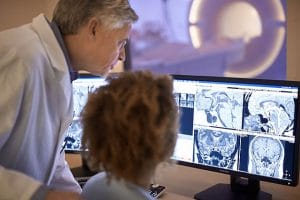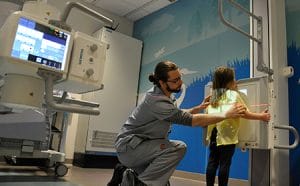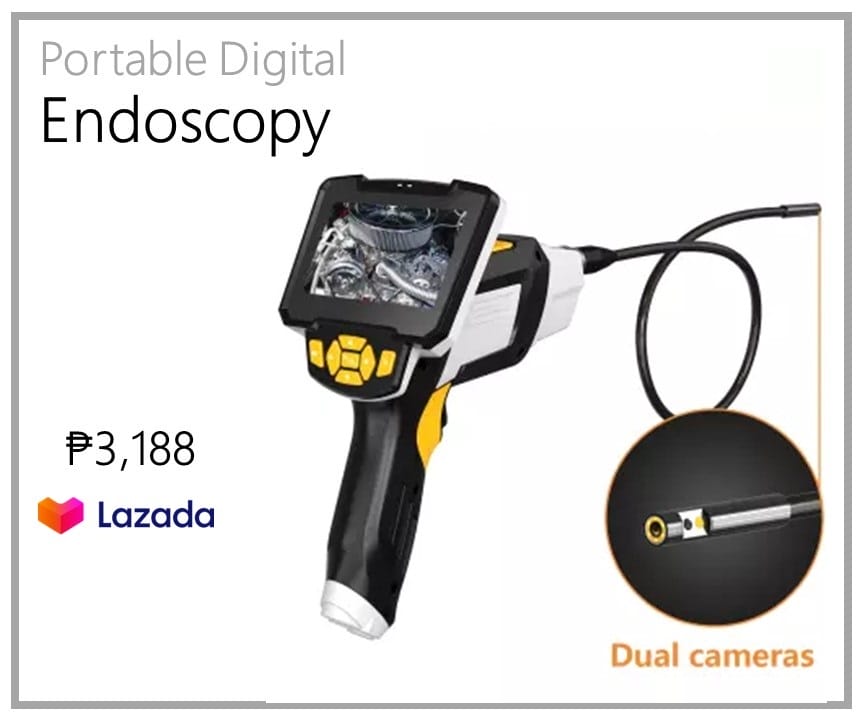Table of Contents
If you’re curious about what radiologic technology is, how it works, and what kinds of jobs are available in the field, you’ve come to the right place! In this article, we’ll explain everything you need to know about radiologic technology and provide an overview of the different career paths you can take within the field. We’ll also highlight some of the exciting new technologies that are being developed in radiologic technology.
Introduction: What is Radiologic Technology?
What is radiologic technology? Radiologic technology, also known as RadTech or medical imaging, is the process of creating images of the body for diagnostic and therapeutic purposes. These images are created using various forms of radiation, including X-rays, ultrasound, and magnetic resonance imaging (MRI). Radiologic technologists use these images to help diagnose medical conditions and diseases.
How Radiologic Technology Works
When most people think of radiologic technology, they think of x-rays. However, radiologic technology is much more than that. It includes a variety of imaging technologies used to diagnose and treat medical conditions.
How radiologic technology works? Radiologic technology works by taking a picture of the inside of an organ or body part. The image is created using x-rays, magnetic resonance imaging (MRI), ultrasound, and computed tomography (CT).
Career Path of Radiologic Technologist
Radiologic technologists are responsible for taking x-rays and other medical images. They may also use equipment to produce images of the inside of the body for diagnosis. Radiologic technologists typically have an associate’s degree from an accredited radiologic technology program. After graduation, they may be certified by the American Registry of Radiologic Technologists (ARRT). Radiologic technologists may work in hospitals, medical clinics, and other healthcare facilities.

New Technologies in Radiologic Technology
In the medical field, radiologic technology is a vital part of diagnosing and treating patients. The technology has come a long way in recent years, with new advancements in imaging technology making it easier and faster to get accurate diagnoses.
Let’s take a look at some of the latest technologies in radiologic technology and how they’re helping to improve patient care.
Here are the top 5 technologies advancing in RadTech:
1. Artificial Intelligence and Machine Learning in Radiologic Technology
In recent years, there has been an increasing use of artificial intelligence (AI) and machine learning (ML) in radiologic technology. AI and ML are used to process images and identify abnormalities. They can also be used to improve the accuracy of diagnoses and treatment plans.
2. Liquid biopsy in Radiologic Technology
In radiologic technology, a liquid biopsy is a procedure that involves withdrawing a small amount of body fluid, such as blood or urine, for examination. The goal of a liquid biopsy is to detect the presence of cancer cells in the body. This test can be used to diagnose cancer, track the progression of the disease, and determine how well treatment is working.
3. Deep learning in Radiologic Technology
Deep learning is a current buzzword in the field of radiologic technology. What is deep learning, and why is it important? Deep learning is a type of machine learning that enables computers to learn from data representations, rather than task-specific algorithms. This makes it possible for computers to learn more complex concepts and generalize from experience.
4. Computing Platforms in Radiologic Technology
Computing platforms are an important part of radiologic technology. They allow radiologic technologists to capture images and other information, and to store and share it with others. There are a number of different computing platforms in use today, including personal computers, smartphones, and tablets. They allow healthcare professionals to view and interact with images and data.
5. Patient comfort in Radiologic Technology
Radiologic technology is the use of radiation to produce images of the body for medical purposes. Radiologic technologists use equipment that emits X-rays and other forms of radiation to produce these images. This equipment can be used to diagnose and treat medical conditions. Radiologic technology is a vital part of the medical field, allowing doctors to diagnose and treat patients. However, the process can be intimidating for patients.

Conclusion: 3 Takeaways about Radiologic Technology
1. Radiologic technology is a field of medicine that uses imaging techniques to diagnose and treat medical conditions.
2. Radiologic technologists use x-rays, MRIs, and other imaging technologies to create images of the body that can be used to diagnose medical conditions.
3. Radiologic technologists are responsible for taking care of patients and operating imaging equipment.
FAQ About Radiologic Technology
What is the difference between radiographer and radiologic technologist?
Radiologic technologists and radiographers are both integral members of the healthcare team. They use imaging technologies to diagnose and treat patients. Though they share many common tasks, there are some key differences between these two professions.
Radiologic technologists typically have an associate’s degree in radiography. They are responsible for operating radiologic equipment and producing images of the body. While Radiographer is a more general term that refers to a person who works with the imaging equipment or studies. In order to become a Radiographer, you must have a bachelor’s degree in radiography and one year of relevant experience.
They are both responsible for creating images of the inside of the body using medical equipment. However, a radiologic technologist typically has more training than a radiographer.
What is medical imaging technology?
Medical imaging technology is a branch of medicine that uses various imaging techniques to diagnose and treat medical conditions. Imaging technologies include x-ray, ultrasound, computed tomography (CT), magnetic resonance imaging (MRI), and positron emission tomography (PET). Each technology has its own unique benefits and drawbacks. For example, x-rays are good for viewing bone fractures, but can be harmful to the body if used in excess.
What do radiographers do at work?
Radiographers are responsible for creating and interpreting medical images using MRI, x-rays, ultrasound, and other imaging technologies. They work in hospitals, clinics, and private practices to help diagnose and treat medical conditions. Radiographers typically work with a team of doctors and other healthcare professionals to provide the best care for their patients.
What are the Duties of Radiology Technologist?
Radiologic technologists typically do the following:
1. Examine X-rays and other types of radiologic images to diagnose a patient’s medical problems.
2. Prepare X-rays, sometimes using radiation, to investigate the cause of injury or disease.
Do Radiologic Technologists make good money?
Radiologic technologists play an important role in the medical field, helping to diagnose and treat patients. The work they do is critical, and it is no surprise that they often make good money.
According to recent data, radiologic technologists earn an average salary of over $60,000 a year. This is significantly more than the average wage for most jobs.
What are career opportunities for Radiography?
Radiography is a career that is constantly growing. There are many opportunities for radiographers in different settings, including hospitals, clinics, and private practices. Radiography offers a variety of job opportunities with different working hours and pay rates. Radiographers also have the opportunity to specialize in different areas of radiography, such as mammography or radiation therapy.
How much do Radiologic Technologists make an hour?
The average salary for a Radiologic Technologist is $52.74 per hour. The median annual wage for technologists was $75,200 in May 2015, according to the Bureau of Labor Statistics (BLS). This would make the mean hourly rate $36.94.
Where Does a Radiologic Technologists Work?
A radiologic technologist may work in a variety of settings, including hospitals, clinics, and private practices. Radiologic technologists may specialize in different types of imaging, such as x-rays, MRIs, or ultrasounds. They are responsible for ensuring that images are high quality and accurate.

Is Radiologic Technologists School Hard?
If you’re considering a career in radiologic technology, you may be wondering if the schooling is hard. The good news is that radiologic technologists school is not as hard as you may think. However, it is important to keep in mind that there are several different areas of specialization within this field, and you may need to complete some additional coursework or training to qualify for the specialty you’re interested in.
Is Radiologic Technologists a Good Job?
When it comes to a career, there are many factors to consider. Money, job security, and the ability to advance are all important things to think about.
Radiologic technologists are in high demand and their job is projected to grow significantly in the next decade. They have a median annual salary of $57,200 and typically work in a hospital setting. Radiologic technologists are responsible for taking x-rays and other medical images. This is a good job for someone who likes working with people and wants a career in the medical field.
Radiologic technologists have one of the most interesting jobs in the medical field. They are responsible for taking x-rays and other medical images. This is a very important job because these images help doctors diagnose and treat patients.
Is Radiologic Technology a Good Career?
Radiologic technology is a good career because it is in high demand, has a stable job market, and pays well. Radiologic technologists are in high demand because they are needed to diagnose and treat medical conditions. The job market for radiologic technologists is stable because there is always a need for them in hospitals and clinics. Radiologic technologists earn a good salary because their skills are in high demand.
Who is Hiring Radiologic Technologists?
Radiologic technologists are in high demand and are responsible for diagnostic imaging procedures. They may work in various healthcare settings, including hospitals, clinics, and doctor’s offices. Radiologic technologists may specialize in different modalities, such as computed tomography (CT), magnetic resonance imaging (MRI), and positron emission tomography (PET).
What are the educational requirements?
If you’re curious about radiologic technology, you may be wondering what the educational requirements are. Generally, radiologic technologists need an associate’s degree from an accredited radiography program. However, some employers may accept a certificate from a vocational or technical school. In addition, most countries in Asia and the Pacific require radiologic technologists to be licensed.













